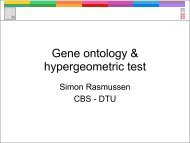Computational tools and Interoperability in Comparative ... - CBS
Computational tools and Interoperability in Comparative ... - CBS
Computational tools and Interoperability in Comparative ... - CBS
You also want an ePaper? Increase the reach of your titles
YUMPU automatically turns print PDFs into web optimized ePapers that Google loves.
Environmental Microbiology (2007) doi:10.1111/j.1462-2920.2007.01483.x<br />
Global features of the Alcanivorax borkumensis<br />
SK2 genome<br />
Oleg N. Reva, 1,3 Peter F. Hall<strong>in</strong>, 2 Hanni Willenbrock, 2<br />
Thomas Sicheritz-Ponten, 2 Burkhard Tümmler 1 <strong>and</strong><br />
David W. Ussery 2<br />
1 Kl<strong>in</strong>ische Forschergruppe, OE6711, Mediz<strong>in</strong>ische<br />
Hochschule Hannover, Carl-Neuberg-Strasse 1,<br />
D-30625 Hannover, Germany.<br />
2 Center for Biological Sequence Analysis, Technical<br />
University of Denmark, Lyngby, Denmark.<br />
3 Biochemistry Department, University of Pretoria,<br />
Lynnwood Road, Hillcrest, 0002 Pretoria, South Africa.<br />
Summary<br />
The global feature of the completely sequenced<br />
Alcanivorax borkumensis SK2 type stra<strong>in</strong> chromosome<br />
is its symmetry <strong>and</strong> homogeneity. The orig<strong>in</strong><br />
<strong>and</strong> term<strong>in</strong>us of replication are located opposite<br />
to each other <strong>in</strong> the chromosome <strong>and</strong> are discerned<br />
with high signal to noise ratios by maximal oligonucleotide<br />
usage biases on the lead<strong>in</strong>g <strong>and</strong> lagg<strong>in</strong>g<br />
str<strong>and</strong>. Genomic DNA structure is rather uniform<br />
throughout the chromosome with respect to <strong>in</strong>tr<strong>in</strong>sic<br />
curvature, position preference or base<br />
stack<strong>in</strong>g energy. The orthologs <strong>and</strong> paralogs of<br />
A. borkumensis genes with the highest sequence<br />
homology were found <strong>in</strong> most cases among<br />
g-Proteobacteria, with Ac<strong>in</strong>etobacter <strong>and</strong> P. aerug<strong>in</strong>osa<br />
as closest relatives. A. borkumensis shares<br />
a similar oligonucleotide usage <strong>and</strong> promoter<br />
structure with the Pseudomonadales. A comparatively<br />
low number of only 18 genome isl<strong>and</strong>s with<br />
atypical oligonucleotide usage was detected <strong>in</strong> the<br />
A. borkumensis chromosome. The gene clusters that<br />
confer the assimilation of aliphatic hydrocarbons, are<br />
localized <strong>in</strong> two genome isl<strong>and</strong>s which were probably<br />
acquired from an ancestor of the Yers<strong>in</strong>ia l<strong>in</strong>eage,<br />
whereas the alk genes of Pseudomonas putida still<br />
exhibit the typical Alcanivorax oligonucleotide signature<br />
<strong>in</strong>dicat<strong>in</strong>g a complex evolution of this major<br />
hydrocarbonoclastic trait.<br />
Received 8 August, 2007; accepted 26 September, 2007.<br />
*For correspondence. E-mail tuemmler.burkhard@mh-hannover.de;<br />
Tel. (+49) 511 5322920; Fax (+49) 511 5326723.<br />
Introduction<br />
Alcanivorax borkumensis stra<strong>in</strong> SK2 is a cosmopolitan<br />
oil-degrad<strong>in</strong>g oligotrophic mar<strong>in</strong>e g-proteobacterium<br />
(Yakimov et al., 1998). The SK2 stra<strong>in</strong> is the paradigm for<br />
hydrocarbonoclastic bacteria that are specialized for<br />
hydrocarbon degradation but have an otherwise highly<br />
restricted substrate spectrum, be<strong>in</strong>g capable of utiliz<strong>in</strong>g<br />
only a few organic acids such as pyruvate, but not simple<br />
sugars, for growth (Yakimov et al., 1998; Sabirova et al.,<br />
2006). A. borkumensis is present <strong>in</strong> low abundance <strong>in</strong><br />
unpolluted environments, but it rapidly becomes the dom<strong>in</strong>ant<br />
bacterium <strong>in</strong> oil-polluted open ocean <strong>and</strong> coastal<br />
waters, where it can constitute 80–90% of the oildegrad<strong>in</strong>g<br />
microbial community (Harayama et al., 1999;<br />
Kasai et al., 2001; 2002; Syutsubo et al., 2001; Röl<strong>in</strong>g<br />
et al., 2002; Hara et al., 2003; McKew et al., 2007a,b).<br />
The genome of A. borkumensis was recently<br />
sequenced <strong>and</strong> annotated (Schneiker et al., 2006). In this<br />
paper, we perform a genome wide comparative genomics<br />
analysis <strong>and</strong> a detailed characterization of the global<br />
features of the A. borkumensis stra<strong>in</strong> SK2 genome. This<br />
work on A. borkumensis stra<strong>in</strong> SK2 aimed to visualize the<br />
prospective potential of genome l<strong>in</strong>guistic approaches<br />
for functional <strong>and</strong> comparative analysis of bacterial<br />
genomes.<br />
Results <strong>and</strong> discussion<br />
©2007TheAuthors<br />
Journal compilation © 2007 Society for Applied Microbiology <strong>and</strong> Blackwell Publish<strong>in</strong>g Ltd<br />
DNA structure <strong>and</strong> highly expressed genes<br />
The genome atlas (Fig. 1) shows a comb<strong>in</strong>ation of some<br />
general <strong>in</strong>formative properties of the chromosome.<br />
These are structural features (<strong>in</strong>tr<strong>in</strong>sic curvature, stack<strong>in</strong>g<br />
energy <strong>and</strong> position preference), repeat properties (global<br />
direct <strong>and</strong> <strong>in</strong>verted repeats) <strong>and</strong> the ma<strong>in</strong> base composition<br />
features (GC skew <strong>and</strong> percent AT). Stack<strong>in</strong>g energy<br />
measures helix rigidity <strong>and</strong> position preference is a<br />
flexibility measure (Jensen et al., 1999; Pedersen et al.,<br />
2000). Regions that exhibit low position preference correlate<br />
with an enrichment of highly expressed genes (Dlakic<br />
et al., 2004; Willenbrock <strong>and</strong> Ussery, 2007). Examples <strong>in</strong><br />
A. borkumensis are the rrn operons, the genes encod<strong>in</strong>g<br />
ribosomal prote<strong>in</strong>s <strong>and</strong> the gene cluster labelled rpoC on<br />
the atlas which among others encodes RNA polymerase<br />
subunits. Low position preference was found to correlate<br />
with high codon adaptation <strong>in</strong>dices as the common









